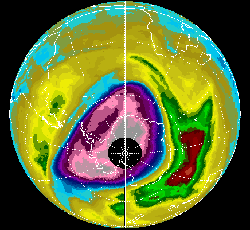Ozone Layer Burned by Cosmic Rays

Cosmic rays may be enlarging the hole in the ozone layer, according to a study appearing in the 13 August print issue of PRL. Researchers analyzed data from several sources, and found a strong correlation between cosmic ray intensity and ozone depletion. Back in the lab they demonstrated a mechanism by which cosmic rays could cause a buildup of ozone-depleting chlorine inside polar clouds. Their results suggest that the damage done by cosmic rays could be millions of times larger than anyone previous believed and may force atmospheric scientists to reexamine their models of the antarctic ozone hole.
For the past two decades, scientists have known that human-made chlorofluorocarbons (CFCs) are the major destroyers of the atmosphere’s protective ozone layer. Atmospheric scientists have proposed that ultraviolet light breaks down CFCs, releasing active chlorine, which tears apart ozone molecules. But during the months when ozone depletion is greatest, giant clouds of ice particles–so-called polar stratospheric clouds–block the ultraviolet rays. Experts have not completely solved this piece of the ozone destruction puzzle, but according to one theory, the clouds harbor active chlorine molecules. Yet it’s not clear how the chlorine would come to be separated from the CFCs in this ultraviolet-free environment.
Leon Sanche and Qing-Bin Lu of the University of Sherbrooke in Canada now believe that cosmic rays–high-energy radiation from deep space–may be breaking down the CFCs buried in the polar clouds. The two studied ozone and cosmic ray data taken by ground stations, balloons, and satellites, and found some surprising relationships. Ozone depletion seemed to be greatest at altitudes and latitudes of high cosmic ray ionization intensity. What’s more, they found a strong correlation between the variation of global ozone levels and the intensity of cosmic rays during the period from 1979 to 1992. This evidence motivated Sanche and Lu to look for a mechanism connecting cosmic rays with CFC breakdown.
Atmospheric chemists have already studied the effects of cosmic ray ionization on CFCs, according to Sanche, but no one has looked at the effects of cosmic rays inside polar clouds. To simulate a dense, antarctic cloud, Sanche and Lu cooled a metal rod down to temperatures between 20 and 100 K and condensed water vapor and CFCs onto its surface. They then bombarded the condensate with low-energy electrons like those created by cosmic rays ionizing atoms in the atmosphere. The electrons reacted with the CFCs and made active chlorine, and the team determined the likelihood of this reaction by measuring the charge buildup on the end of the rod.
The results suggest that electrons from cosmic rays are about a million times more likely to interact with CFCs inside polar clouds than anyone previously believed, says Sanche. Robert Compton of the University of Tennessee says that Sanche and Lu’s revised estimations could help atmospheric scientists and meteorologists to improve their models of ozone loss. Sanche says these observations may also change the way we understand the ozone hole. A rise in global temperatures could cause an increase in polar cloud cover that would lead to more cosmic-ray-induced CFC reactions, he says. “So here you would predict some link between global warming and [the ozone hole].”
–Geoff Brumfiel
More Information
First response to this paper: Phys. Rev. Lett. 89, 219801 (18 NOV 2002).


